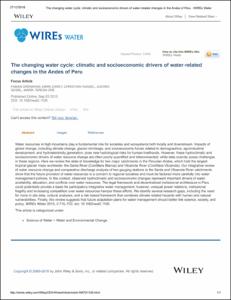Mostrar el registro sencillo del ítem
The changing water cycle: climatic and socioeconomic drivers of water-related changes in the Andes of Peru
| dc.contributor.author | Drenkhan, Fabian | |
| dc.contributor.author | Carey, Mark | |
| dc.contributor.author | Huggel, Christian | |
| dc.contributor.author | Seidel, Jochen | |
| dc.contributor.author | Oré, María Teresa | |
| dc.coverage.spatial | Cordillera Blanca | |
| dc.date.accessioned | 2018-12-31T13:11:43Z | |
| dc.date.available | 2018-12-31T13:11:43Z | |
| dc.date.issued | 2015-09 | |
| dc.identifier.citation | Drenkhan, F., Carey, M., Huggel, C. et al. (2015) The changing water cycle: climatic and socioeconomic drivers of water-related changes in the Andes of Peru. Wiley Interdisciplinary Reviews: Water, 2(6), 715-733. doi: https://doi.org/10.1002/wat2.110https://doi.org/10.1002/wat2.110 | es_PE |
| dc.identifier.issn | ESSN: 2049-1948 | es_PE |
| dc.identifier.uri | https://hdl.handle.net/20.500.12543/3192 | |
| dc.description | Original abstract: Water resources in high mountains play a fundamental role for societies and ecosystems both locally and downstream. Impacts of global change, including climate change, glacier shrinkage, and socioeconomic forces related to demographics, agroindustrial development, and hydroelectricity generation; pose new hydrological risks for human livelihoods. However, these hydroclimatic and socioeconomic drivers of water resource change are often poorly quantified and interconnected, while data scarcity poses challenges in these regions. Here we review the state of knowledge for two major catchments in the Peruvian Andes, which hold the largest tropical glacier mass worldwide: the Santa River (Cordillera Blanca) and Vilcanota River (Cordillera Vilcanota). Our integrative review of water resource change and comparative discharge analysis of two gauging stations in the Santa and Vilcanota River catchments show that the future provision of water resources is a concern to regional societies and must be factored more carefully into water management policies. In this context, observed hydroclimatic and socioeconomic changes represent important drivers of water availability, allocation, and conflicts over water resources. The legal framework and decentralized institutional architecture in Peru could potentially provide a basis for participatory integrative water management; however, unequal power relations, institutional fragility and increasing competition over water resources hamper these efforts. We identify several research gaps, including the need for more in situ data, cultural analyses, and a risk-based framework that combines climate-related hazards with human and natural vulnerabilities. Finally, this review suggests that future adaptation plans for water management should better link science, society, and policy. | es_PE |
| dc.description | Artículo en período de embargo | es_PE |
| dc.description.abstract | Manifiesta que los recursos hídricos de las altas montañas desempeñan un papel fundamental para las sociedades y los ecosistemas, tanto a nivel local como a nivel descendente y que los impactos del cambio global plantean nuevos riesgos hidrológicos para los medios de vida humanos. Señala que estos impulsores hidroclimáticos y socioeconómicos del cambio en los recursos hídricos a menudo están poco cuantificados e interconectados y que la escasez de datos plantea desafíos en estas regiones. En este sentido, revisa el estado de conocimiento de dos cuencas principales en los Andes peruanos, que tienen la mayor masa glaciar tropical del mundo: el río Santa (Cordillera Blanca) y el río Vilcanota (Cordillera Vilcanota). Esta revisión integradora del cambio de recursos hídricos y el análisis comparativo de descargas de dos estaciones de aforo en las cuencas de los ríos Santa y Vilcanota muestran que la provisión futura de recursos hídricos es una preocupación y debe incluirse más cuidadosamente en las políticas de gestión del agua y la importancia del marco legal adecuado y la arquitectura institucional descentralizada en este contexto. | es_PE |
| dc.format | application/pdf | es_PE |
| dc.language.iso | eng | es_PE |
| dc.publisher | Wiley | es_PE |
| dc.relation.ispartofseries | Wiley Interdisciplinary Reviews: Water, November/December 2015, Volume 2, Issue 6, pp. 715-733 | es_PE |
| dc.relation.uri | http://wires.wiley.com/WileyCDA/WiresArticle/wisId-WAT21105.html | |
| dc.rights | info:eu-repo/semantics/closedAccess | es_PE |
| dc.rights | Attribution-NonCommercial-NoDerivatives 4.0 International | * |
| dc.rights.uri | https://creativecommons.org/licenses/by-nc-nd/4.0/ | * |
| dc.source | Autoridad Nacional del Agua | es_PE |
| dc.source | Repositorio institucional - ANA | es_PE |
| dc.subject | Riesgos de disponibilidad hídrica | es_PE |
| dc.subject | Gestión de riesgos de desastres en recursos hídricos | es_PE |
| dc.subject | Monitoreo de lagunas y glaciares | es_PE |
| dc.title | The changing water cycle: climatic and socioeconomic drivers of water-related changes in the Andes of Peru | es_PE |
| dc.type | info:eu-repo/semantics/article | es_PE |
| dc.identifier.doi | https://doi.org/10.1002/wat2.110 | es_PE |








